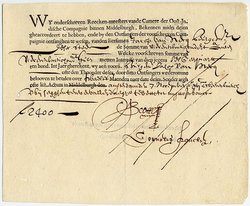Dutch East India Company
|
|
- This article is about the trading company. For the record label, see Dutch East India Trading.
NetherlandsEmpire.png
The Dutch East India Company (Vereenigde Oostindische Compagnie or VOC in Dutch, literally "United East Indies Company") was established on March 20, 1602, when the Estates-General of the Netherlands granted it a monopoly to carry out colonial activities in Asia. It was the first multinational company and the first company to issue stocks and bonds.
The VOC consisted of 6 Chambers (Kamers) in Amsterdam, Middelburg (for Zeeland), Enkhuizen, Delft, Hoorn and Rotterdam. Delegates of these chambers convened as the Heeren XVII (the Lords Seventeen).
To the counsel of Heeren XVII, eight delegates were provided by the Chamber of Amsterdam, four from Chamber Zeeland and one from each of the smaller Chambers. Access to the seventeenth seat was rotated among the Chamber of Zeeland or one of the smaller Chambers. Amsterdam had thereby no decisive voice. Particularly the Zeelanders were at the start up of the VOC suspicious for this. This fear was not unfounded, because in practice it meant that indeed Amsterdam stipulated what happened.
The start up capital of the Dutch East India Company was; f. 6.424.588 and was raised by the 8 chambers;
- The Chamber of Hoorn raised an amount of f. 266.868.
- The Chamber of Delft raised an amount of f. 469.400.
- The Chamber of Zeeland raised an amount of f. 1.300.405.
- The Chamber of Amsterdam raised an amount of f. 3.679.915.
- The Chamber of Rotterdams raise of capital did not run so smoothly. They brought in f. 173.000 which satisfied by far, the expectations. A considerable part was originating from inhabitants of Dordrecht.
- The Chamber of Enkhuizen after the chambers of Amsterdam and Zeeland with f. 540.000 had the largest input in the share capital of VOC. Under the first 358 share holders, were many small entrepreneurs, which dared to take the risk.
- At the registration in the share register of the VOC, immigrants played an important role. Under the 1143 tenderers were themselves 39 Germans and no less than 301 Zuid-Nederlanders (Belgium); under who, Isaäc le Maire who was the largest subscriber with f. 85.000.
Voc_logo.gif
The Heeren XVII met alternately 6 years in Amsterdam and 2 years in Middelburg. They defined the VOCs general policy and divided the tasks among the Chambers. The Chambers carried out all the necessary work, built their own ships and warehouses and traded the merchandise. The Heeren XVII sent the ships masters off with extensive instructions on the route to be navigated, prevailing winds, currents, shoals and landmarks. The VOC also produced its own sea charts.
The company established its headquarters in Batavia on Java (now Jakarta, Indonesia). Other colonial outposts were also established in the East Indies what later became Indonesia, such as on the Spice Islands (Moluccas), which include the Banda Islands where the VOC forcibly maintained a monopoly over nutmeg and mace. Methods used to maintain the monopoly included the violent suppression of the native population, not stopping short of extortion and mass murder.

A more peaceful VOC trade post on Dejima, an artificial island off the coast of Nagasaki, was for a long time the only place where Europeans could trade with Japan.
In 1652, Jan van Riebeeck established an outpost at the Cape of Good Hope (the southwestern tip of Africa, currently in South Africa) to re-supply VOC ships on their journey to East Asia. This post later became a fully-fledged colony, the Cape Colony, when more Dutch and other Europeans started to settle there. VOC outposts were also established in Persia (now Iran), Bengal (now Bangladesh and part of India), Ceylon (now Sri Lanka), Malacca (Melaka, now in Malaysia), Siam (now Thailand), mainland China (Canton), Formosa (now Taiwan) and southern India. In 1662, Koxinga expelled the Dutch from Taiwan (see History of Taiwan).
By 1669, the VOC was the richest private company the world had ever seen, with over 150 merchant ships, 40 warships, 50,000 employees, a private army of 10,000 soldiers, and a dividend payment of 40%.
The company was in almost constant conflict with the English; relations were particularly embittered after the Amboyna Massacre in 1623. During the 18th century, its possessions were increasingly focused on the East Indies. After the fourth war between the United Provinces and England (1780–1784), the VOC got into financial trouble, and in 1799, the company was dissolved, four years after the end of the States General. The East Indies were awarded to The Kingdom of the Netherlands by the Congress of Vienna in 1815.
VOC ships
Replica_Amsterdam.jpg
See also
- Jan Pieterszoon Coen
- The British East India Company, founded in 1600
- The Danish East India Company, founded in 1616
- The Dutch West India Company, founded in 1621
- The French East India Company, founded in 1664
- The Swedish East India Company, founded in 1731
- The novel Dune, inspired by the exploits of the V.O.C.
External links
- Oldest share (http://www.oldest-share.com/) — the oldest share in the world (VOC 1606)
- A taste of adventure — The history of spices is the history of trade (http://www.economist.com/displayStory.cfm?Story_ID=179810), The Economist, December 17, 1998.
- Dutch Portuguese Colonial History (http://www.colonialvoyage.com/)
Template:Former Dutch coloniesaf:Verenigde Oos-Indiese Kompanjie de:Niederländische Ostindien-Kompanie eo:Nederlanda Orienthinda Kompanio fr:Compagnie néerlandaise des Indes orientales id:VOC it:Compagnia Olandese delle Indie Orientali nl:Vereenigde Oostindische Compagnie ja:オランダ東インド会社 no:Det nederlandske Ostindiske kompani sv:Holländska Östindiska Kompaniet zh:荷兰东印度公司
